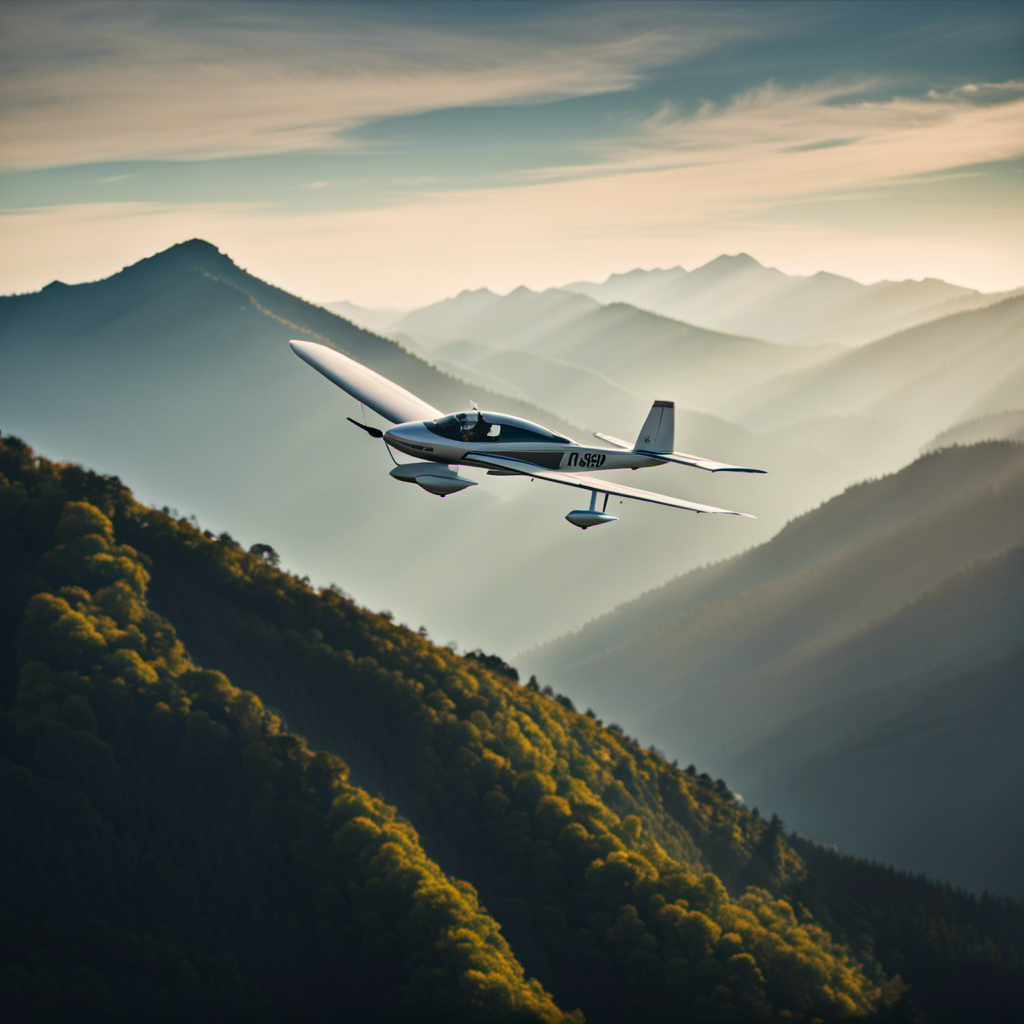As a pilot, I’ve always been captivated by the concept of flying high in the sky like a bird, smoothly navigating through the air. That’s why I’m excited to introduce you to the amazing realm of glider flying and the Glider Add-On Rating.
This rating unlocks new heights, allowing pilots to experience the unique thrill of flying without an engine. In this article, we’ll explore what the Glider Add-On Rating is, how to obtain it, and the many benefits and safety considerations it entails.
Get ready to soar to new heights with this exhilarating rating.
Key Takeaways
- The Glider Add-On Rating allows pilots to fly gliders alongside their existing airplane rating, providing a thrilling experience of soaring without an engine.
- Obtaining the Glider Add-On Rating requires specific training, including learning about glider aerodynamics, navigation principles, and meteorology, as well as practicing pre-flight inspections and weight and balance calculations.
- Benefits of the Glider Add-On Rating include expanding the pilot’s skill set with new techniques and strategies, opportunities for adventure and exploration, enhanced understanding of aerodynamics and piloting skills, and a sense of freedom and tranquility in gliding.
- Safety considerations for glider flying include essential pre-flight checks, monitoring weather patterns to avoid turbulence, knowledge of emergency procedures for safe landings, thorough understanding of safety measures, and ensuring a smooth and secure flight.
What is the Glider Add-On Rating?
So, what’s the deal with the glider add-on rating?
The glider add-on rating is an additional qualification that allows pilots to fly gliders in addition to their existing airplane rating. It opens up a whole new world of aviation, offering the opportunity to experience the thrill of soaring through the skies with only the power of the wind.
With this rating, pilots can enjoy the tranquility and freedom of glider flight, exploring the beauty of the landscape from a unique perspective. Obtaining the glider add-on rating requires undergoing specific training and passing a practical exam to demonstrate proficiency in glider operations.
How to Obtain the Glider Add-On Rating
To obtain the glider add-on rating, you’ll need to complete a series of training modules. Here is a breakdown of the steps involved:
- Familiarize yourself with the glider’s aerodynamics and flight characteristics.
- Learn the principles of glider navigation and meteorology.
- Practice pre-flight inspections and understand the importance of weight and balance calculations.
- Demonstrate your ability to safely launch, fly, and land a glider.
By following this structured training program, you will acquire the necessary knowledge and skills to earn your glider add-on rating.
Once you have completed the training, you will be able to confidently soar through the skies in a glider, experiencing the thrill of unpowered flight. This rating opens up a whole new world of aviation possibilities, allowing you to explore remote areas, gain a deeper understanding of aerodynamics, and refine your piloting skills.
Benefits of the Glider Add-On Rating
As an avid pilot, I can attest to the incredible thrill and sense of freedom that comes with gliding. With the glider add-on rating, pilots can experience the exhilaration of soaring through the skies without an engine.
Not only does gliding provide a unique and thrilling aviation experience, but it also expands a pilot’s skill set by requiring them to master new techniques and strategies.
Additionally, the glider add-on rating opens up a world of opportunities for adventure and exploration, allowing pilots to discover new and remote locations from a whole new perspective.
Thrill and Freedom of Gliding
The thrill and freedom of gliding is an unparalleled experience that can’t be replicated in any other form of aviation. The sensation of soaring through the sky, using only the power of the wind to stay aloft, is truly exhilarating. As a glider pilot, I have had the privilege of experiencing this unique form of flight, and it has opened up a whole new world of possibilities for me.
Here are some of the reasons why gliding is so special:
-
The quiet serenity: Gliding allows you to experience the tranquility of flight without the noise and vibration of an engine. It’s just you and the wind, peacefully gliding through the air.
-
The sense of connection: Gliding provides a direct connection to the elements, as you rely solely on the natural forces of the atmosphere to keep you airborne. You become one with the air, constantly reading its movements and adjusting your flight accordingly.
-
The challenge and skill: Gliding requires a deep understanding of aerodynamics and meteorology, as well as precise control inputs. It’s a constant dance between pilot and aircraft, where every decision and action has a direct impact on the flight.
Expanded Aviation Skills
Developing your skills in gliding can greatly enhance your overall proficiency as an aviator. It allows you to approach powered flight with a newfound expertise. Gliding requires a deep understanding of aerodynamics and precise control inputs to maintain optimal glide ratios.
By mastering the art of gliding, you will sharpen your instincts for reading the air currents and making accurate judgments about weather conditions. This increased awareness will transfer over to powered flight, enabling you to make more informed decisions during takeoffs, landings, and maneuvers.
Additionally, gliding requires a high level of situational awareness and strategic planning. You navigate through thermals and lift zones to maximize your altitude and distance. These expanded aviation skills acquired through gliding will undoubtedly enhance your overall flying capabilities.
They pave the way for new adventures and explorations in the world of aviation.
Opportunities for Adventure and Exploration
Imagine the exhilaration of discovering new horizons and embarking on thrilling adventures as you explore the vast skies through gliding.
Glider flying offers a unique opportunity to experience the freedom and serenity of flight, without the noise and reliance on an engine. As a glider pilot, you have the chance to soar gracefully through the air, using nature’s elements to stay aloft.
The absence of an engine means you can truly connect with the environment, feeling the wind against your face and hearing the sound of silence. Gliding allows you to explore new territories, navigate challenging weather conditions, and witness breathtaking views from above.
It is a sport that combines skill, precision, and a deep understanding of aerodynamics. However, before taking to the skies, it is essential to consider the safety aspects of glider flying, ensuring a secure and enjoyable experience.
Safety Considerations for Glider Flying
Before taking to the skies in a glider, you should carefully consider the safety precautions involved and ensure that you are well-prepared for potential risks. Glider flying may seem exhilarating, but it requires a thorough understanding of safety measures to ensure a smooth and secure flight. Here are some key safety considerations to keep in mind:
| Safety Precautions | Importance |
|---|---|
| Pre-flight checks | Essential to ensure the glider is in optimal condition before takeoff |
| Weather conditions | Monitoring weather patterns is crucial to avoid turbulence and unfavorable conditions |
| Emergency procedures | Knowing how to handle emergencies, such as a sudden loss of lift, is vital for a safe landing |
Glider Add-On Rating vs. Other Aviation Ratings
When comparing the Glider Add-On Rating to other aviation ratings, it is important to consider the differences in training and certification.
The training for a glider add-on rating typically involves specific flight training and knowledge exams that are tailored to glider flying.
Additionally, there may be opportunities for cross-credit between the glider add-on rating and other aviation ratings, allowing pilots to build upon their existing knowledge and experience. These cross-credit opportunities can provide a more efficient path to obtaining multiple ratings.
Furthermore, the complementary skills and experiences gained through the glider add-on rating can enhance a pilot’s overall aviation proficiency and broaden their understanding of different flying techniques and environments.
Differences in Training and Certification
The differences in training and certification for the glider add-on rating are crucial to understand. As a pilot pursuing this rating, I have firsthand experience with these distinctions. Here are three key elements to consider:
-
Flight Training: To obtain the glider add-on rating, I had to complete a minimum of 10 hours of flight training, including at least 20 flights. This focused on mastering the unique aspects of glider flight, such as aerodynamics and energy management.
-
Ground Training: In addition to flight training, I had to undergo ground instruction specific to gliders. This covered topics like glider systems, meteorology, and emergency procedures. Understanding these concepts was essential for safe and proficient glider operations.
-
Certification Process: After completing the required training, I had to pass a practical test with an FAA-designated examiner. This evaluation assessed my knowledge and skills in glider flight, ensuring that I met the necessary standards for certification.
Now equipped with the glider add-on rating, I can explore the exciting world of glider flying. But what if I want to expand my aviation qualifications even further? Let’s delve into the cross-credit opportunities available.
Cross-Credit Opportunities
If I want to expand my aviation qualifications even further, I can explore the cross-credit opportunities available. These opportunities allow me to leverage my existing certifications and experience to obtain additional ratings or endorsements with less training and cost.
For example, if I already hold a private pilot license, I may be eligible for a cross-credit towards the glider add-on rating. This means that I can build upon my existing knowledge and skills in powered aircraft to learn the specific techniques and procedures needed for flying gliders.
By taking advantage of these cross-credit opportunities, I can efficiently enhance my aviation capabilities and broaden my horizons in the skies.
Now, let’s delve into the importance of complementary skills and experiences in aviation.
Complementary Skills and Experiences
To enhance your aviation qualifications, exploring complementary skills and experiences is key. Here are three areas to consider:
-
Aerodynamics: Understanding the principles of aerodynamics is crucial for flying gliders. Familiarize yourself with concepts like lift, drag, and airfoil design to enhance your understanding of glider flight.
-
Meteorology: Weather plays a significant role in glider operations. Expand your knowledge of meteorology to better assess weather conditions, identify thermals, and make safe flying decisions.
-
Navigation: Developing strong navigation skills is essential for glider pilots. Learn how to use maps, compasses, and GPS systems to plan and execute glider flights accurately.
By acquiring these complementary skills, you will be well-prepared for the challenges of glider flying.
Now let’s dive into some glider add-on rating success stories, where pilots have achieved remarkable feats with this additional qualification.
Glider Add-On Rating Success Stories
One pilot shared their success story about how the glider add-on rating helped them enhance their flying skills.
As a pilot with prior experience in powered aircraft, I was eager to expand my horizons and explore the world of glider flying. The glider add-on rating provided me with the necessary knowledge and skills to safely operate gliders.
Through rigorous training and hands-on experience, I learned about the unique aerodynamics and flight characteristics of gliders. This rating enabled me to improve my understanding of lift, thermals, and soaring techniques. As a result, I became a more proficient and confident pilot, capable of navigating and maneuvering gliders with precision.
With the glider add-on rating under my belt, I was ready to tackle new challenges and soar to new heights.
Transitioning into the subsequent section about ‘glider add-on rating FAQs’, it’s essential to address common questions that pilots may have regarding this rating.
Glider Add-On Rating FAQs
After hearing about the incredible success stories of pilots who have obtained their Glider Add-On Rating, you may be left with some burning questions. Don’t worry, I’ve got you covered with this comprehensive FAQ section.
Allow me to address your concerns and shed some light on the most commonly asked questions about the Glider Add-On Rating. Whether you’re curious about the requirements, the training process, or the benefits of obtaining this rating, I’ve compiled all the information you need in the table below:
| Question | Answer |
|---|---|
| What are the prerequisites for the rating? | A valid Private Pilot License (PPL) and medical certificate. |
| How long does the training take? | Typically, it takes around 10-15 hours of flight training. |
| Can I fly a glider solo after obtaining the rating? | Yes, you will be authorized to fly a glider without an instructor. |
| What are the benefits of having a Glider Add-On Rating? | It enhances your piloting skills, opens up new flying experiences, and allows you to join gliding clubs and communities. |
Now that we’ve addressed your questions, let’s delve into the exciting world of gliding clubs and communities.
Gliding Clubs and Communities
Joining gliding clubs and communities can provide pilots with a sense of camaraderie and the opportunity to share their passion for gliding with like-minded individuals. These clubs offer a supportive environment where pilots can connect with others who understand the unique challenges and joys of gliding.
Being part of a gliding community also allows pilots to stay informed about the latest developments in the field, such as new techniques, equipment, and safety measures. Through club events, workshops, and social gatherings, pilots can expand their knowledge and skills, while building lasting friendships.
Furthermore, clubs often organize group flights and competitions, offering pilots the chance to test their abilities and push their limits. By immersing themselves in these communities, pilots can continually learn and grow, fostering a lifelong love for gliding.
Transitioning into the next section about ‘glider add-on rating maintenance and renewal’, it is crucial for pilots to stay up-to-date with their glider add-on rating requirements.
Glider Add-On Rating Maintenance and Renewal
To maintain and renew your glider add-on rating, it’s important to stay informed about the latest requirements and regulations. As a pilot, you are responsible for staying up-to-date with the necessary knowledge and skills to safely operate a glider. This includes staying current with the FAA regulations, attending recurrent training courses, and regularly practicing in the glider.
It’s crucial to stay informed about any changes or updates in the industry to ensure that you are always operating within the legal and safe limits. By actively engaging in ongoing training and staying informed, you can ensure that your glider add-on rating remains valid and that you are continuously improving your skills as a glider pilot.
Transition: With a solid understanding of the maintenance and renewal requirements, it’s time to explore the thrilling possibilities that come with the glider add-on rating.
Conclusion: Soaring to New Heights with the Glider Add-On Rating
With the glider add-on rating, I can experience the thrill of soaring to new heights. This rating allows me, as a pilot, to fly gliders, which are aircraft designed for unpowered flight.
Gliders rely on the natural forces of the atmosphere, such as thermals and updrafts, to stay aloft and gain altitude. The glider add-on rating adds an exciting dimension to my flying experience. It requires a thorough understanding of aerodynamics, weather patterns, and glider-specific techniques.
By mastering these skills, I can navigate through the sky with precision and grace. Soaring in a glider provides a unique sense of freedom and tranquility, as I am able to fly silently and effortlessly among the clouds.
The glider add-on rating opens up a whole new world of aviation possibilities, allowing me to reach new heights with every flight.
Frequently Asked Questions
What are the prerequisites for obtaining the Glider Add-On Rating?
To obtain the glider add-on rating, one must hold a private pilot certificate and have a minimum of 20 hours of flight time in gliders, including 10 solo flights. This ensures a solid foundation in glider operation and safety.
Can I use my Glider Add-On Rating to fly gliders in other countries?
No, the glider add-on rating only allows me to fly gliders in the country where I obtained the rating. To fly in other countries, I would need to meet their specific requirements and obtain the necessary ratings or licenses.
Are there any restrictions on flying gliders with the Glider Add-On Rating?
Yes, there are restrictions on flying gliders with the glider add-on rating. These restrictions include limitations on airspace, weather conditions, and operating within the privileges and limitations of the rating.
Can I obtain the Glider Add-On Rating if I already have a pilot’s license for powered aircraft?
Yes, if you already hold a pilot’s license for powered aircraft, you can obtain the glider add-on rating. This allows you to fly gliders in addition to powered aircraft, expanding your flying capabilities.
What is the cost of obtaining and maintaining the Glider Add-On Rating?
Obtaining and maintaining the glider add-on rating can be quite expensive. Costs can include training fees, examination fees, and insurance premiums. However, the joy of soaring through the sky is worth every penny.
Conclusion
In conclusion, the Glider Add-On Rating is a thrilling opportunity for aviation enthusiasts to soar to new heights. By obtaining this rating, pilots can unlock a whole new world of glider flying, experiencing the freedom of the skies like never before.
With the proper training and safety considerations in mind, glider flying can be a truly exhilarating experience. So join the gliding clubs and communities, maintain and renew your rating, and get ready to take flight.
Prepare to witness the breathtaking beauty of the world from above, as you glide effortlessly through the air.
Orion, better known as “Jetstream,” is the voice that brings the stories of the skies to life. His fascination with aviation began at a young age, sparked by his father’s tales of flying and adventure. Orion’s journey into the world of gliding was serendipitous, and from the moment he took his first glider flight, he knew he had found his calling.










